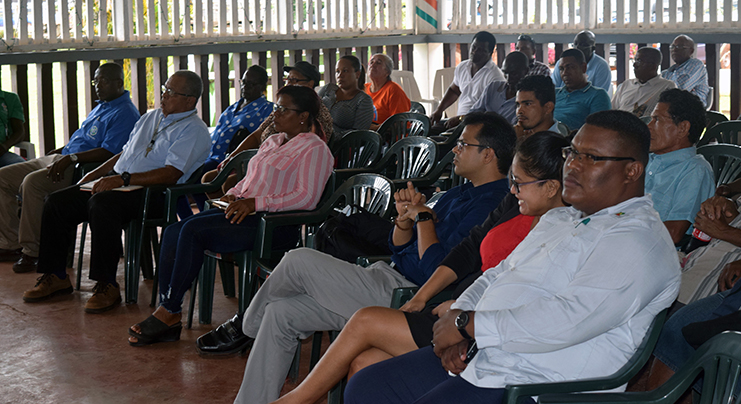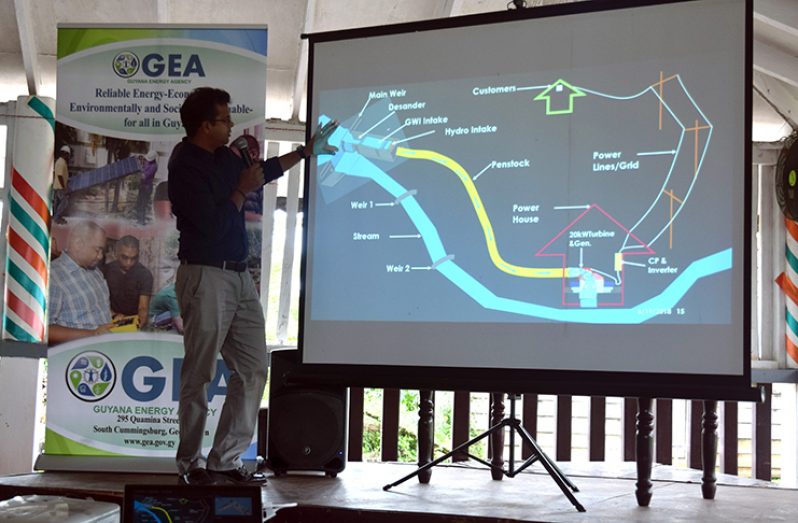–after completion of hydro-power station at Hosororo
WITH the construction of a 20-kilowatt hydro-power station at Hosororo in the North West District (NWD) slated to begin in August, the Guyana Energy Agency (GEA) on Saturday announced that electricity will soon be produced at US$0.21 per kilowatt hour (KWH).
According to the GEA, at US$0.21 per KWH, it will be US$0.29 cheaper to produce electricity from hydropwer than diesel.
In a statement to the media, the GEA said the resuscitated hydropower project will feature a new design that was conceptualised by its engineers, and will entail the construction of a 20kW run-of-the-river-type micro-hydropower plant, inclusive of weir/intake and penstocks, but will use the existing powerhouse after it has undergone repairs. The construction is expected to come to an end in eight months.

Back in 2015, the German Government through its German Agency for International Cooperation (GIZ) initiative, committed to assisting the GEA with developing the project. The US$165,175 project received US$91,108 in financing from the Government of Guyana and US$74,067 in financing from GIZ/REETA.
According to GEA Chief Executive Officer Dr. Mahender Sharma, much work was done over the past three years to ensure that the project came to fruition.
“The project is also serving as a capacity-building exercise for the GEA, as it allows the Hydro-Power Support Engineers of the Agency to gain knowledge and experience of hydro-power development,” Dr Sharma said, adding that the hydropower project was the most economically feasible when compared to solar and diesel.
“While it would cost US$0.50 to produce a kilowatt-hour from diesel, and US$0.36 to produce a kilowatt-hour from solar, hydropower would cost US$0.31 to produce a kilowatt-hour of energy,” he said.
“[But] thanks to grant financing for the project, this cost would reduce to US$0.21/kWh,” he stated at a recently concluded public consultation held in Mabaruma.
Though the Hosororo hydropower plant will contribute only eight per cent of Mabaruma’s energy demand (approximately 64MWh a year), Dr. Sharma said the supply “would help the township diversify its energy mix, provide energy security, and reduce the use of fossil fuel.”
He said, too, that the project is one of very low environmental impact, since structures such as a powerhouse were already in place from the project’s first attempt back in the 80s.
JOB OPPORTUNITIES
Meanwhile, residents of Mabaruma queried possible job opportunities, access to the site for recreational purposes and the sustainability of the project. In response to those queries, Dr Sharma made it clear that several jobs would be available for residents during and after construction.
Sharma pointed to jobs in the areas of surveying, driving, masonry, supervisors, electricians, and accounts. He also explained that residents would not be barred from using the area for recreational purposes, and pledged that the project will not become defunct.
He said that apart from residents themselves, other beneficiaries of the project will be the Guyana Water Inc. (GWI), the National Agricultural Research and Extension institute (NAREI); and the Mabaruma Power Company.
There are currently approximately 700 customers, both residential and commercial, who are connected to the grid.
Regional Chairman Brentnol Ashley thanked the GEA and the Ministry of Public Infrastructure for ensuring that the project was resuscitated. “Initiatives like these will aid the transformative process of the region,” he said.
“I am happy that this is going to become a reality,” he added, while indicating that the Regional Democratic Council (RDC) fully supports the project.
Like the residents present at the public consultation, Ashley called for the GEA to ensure that the project is sustained.
SIGNIFICANT DEVELOPMENT
Mayor of Mabaruma, Henry Smith, also welcomed the project and said that it will lend to significant development of the township.
The GEA intends to use the knowledge and experience gained from the project to continue its efforts towards the development of hydropower across the country in keeping with its vision to provide reliable energy in an economically, environmentally and socially sustainable framework.
Supervision of the project during the construction phase will be done by GEA’s engineers, along with their counterparts from the Hinterland Electrification Company Inc. (HECI), and the Mabaruma Power and Light Company (MPLC).
Additionally, regular updates will be provided to the mayor and councillors of the region, and residents, on the project through meetings and site visits. Residents will be encouraged to monitor the project.
The Hosororo Hydropower Project is one of 67 sites identified in 1976 as having hydropower potential. Situated at the Hosororo Creek, about 4.6 km bees flight to the south-west of Mabaruma, the initial plant was built in the late 1980s to supply electricity to an agricultural produce-processing facility that was built nearby.
The project was abandoned some years after its inauguration.
The team of officials visited Region One (Barima-Waini) from June 18 to 20, and included Hydropower Support Engineers Dolwin Khan and Winston Setal, along with Technician, Christopher Nelson.



.jpg)










